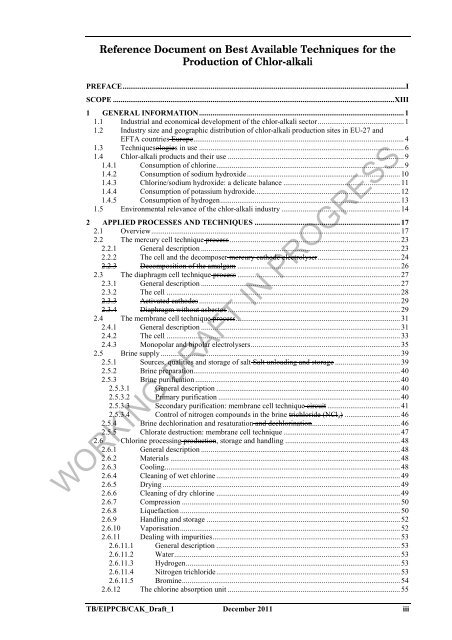(BAT) Reference Document for the Production of Chlor-alkali ...
(BAT) Reference Document for the Production of Chlor-alkali ...
(BAT) Reference Document for the Production of Chlor-alkali ...
Create successful ePaper yourself
Turn your PDF publications into a flip-book with our unique Google optimized e-Paper software.
<strong>Reference</strong> <strong>Document</strong> on Best Available Techniques <strong>for</strong> <strong>the</strong><br />
<strong>Production</strong> <strong>of</strong> <strong>Chlor</strong>-<strong>alkali</strong><br />
PREFACE....................................................................................................................................................I<br />
SCOPE ...................................................................................................................................................XIII<br />
1 GENERAL INFORMATION........................................................................................................... 1<br />
1.1 Industrial and economical development <strong>of</strong> <strong>the</strong> chlor-<strong>alkali</strong> sector............................................. 1<br />
1.2 Industry size and geographic distribution <strong>of</strong> chlor-<strong>alkali</strong> production sites in EU-27 and<br />
EFTA countries Europe.............................................................................................................. 4<br />
1.3 Techniquesologies in use ........................................................................................................... 6<br />
1.4 <strong>Chlor</strong>-<strong>alkali</strong> products and <strong>the</strong>ir use ............................................................................................ 9<br />
1.4.1 Consumption <strong>of</strong> chlorine.................................................................................................. 9<br />
1.4.2 Consumption <strong>of</strong> sodium hydroxide................................................................................ 10<br />
1.4.3 <strong>Chlor</strong>ine/sodium hydroxide: a delicate balance ............................................................. 11<br />
1.4.4 Consumption <strong>of</strong> potassium hydroxide............................................................................ 12<br />
1.4.5 Consumption <strong>of</strong> hydrogen.............................................................................................. 13<br />
1.5 Environmental relevance <strong>of</strong> <strong>the</strong> chlor-<strong>alkali</strong> industry .............................................................. 14<br />
2 APPLIED PROCESSES AND TECHNIQUES ............................................................................ 17<br />
2.1 Overview.................................................................................................................................. 17<br />
2.2 The mercury cell technique process ......................................................................................... 23<br />
2.2.1 General description ........................................................................................................ 23<br />
2.2.2 The cell and <strong>the</strong> decomposer mercury cathode electrolyser........................................... 24<br />
2.2.3 Decomposition <strong>of</strong> <strong>the</strong> amalgam ..................................................................................... 26<br />
2.3 The diaphragm cell technique process ..................................................................................... 27<br />
2.3.1 General description ........................................................................................................ 27<br />
2.3.2 The cell .......................................................................................................................... 28<br />
2.3.3 Activated cathodes ......................................................................................................... 29<br />
2.3.4 Diaphragm without asbestos .......................................................................................... 29<br />
2.4 The membrane cell technique process...................................................................................... 31<br />
2.4.1 General description ........................................................................................................ 31<br />
2.4.2 The cell .......................................................................................................................... 33<br />
2.4.3 Monopolar and bipolar electrolysers.............................................................................. 35<br />
2.5 Brine supply ............................................................................................................................. 39<br />
2.5.1 Sources, qualities and storage <strong>of</strong> salt Salt unloading and storage .................................. 39<br />
2.5.2 Brine preparation............................................................................................................ 40<br />
2.5.3 Brine purification ........................................................................................................... 40<br />
2.5.3.1 General description ................................................................................................ 40<br />
2.5.3.2 Primary purification ............................................................................................... 40<br />
2.5.3.3 Secondary purification: membrane cell technique circuit ...................................... 41<br />
2.5.3.4 Control <strong>of</strong> nitrogen compounds in <strong>the</strong> brine trichloride (NCl3) ............................. 46<br />
2.5.4 Brine dechlorination and resaturation and dechlorination.............................................. 46<br />
2.5.5 <strong>Chlor</strong>ate destruction: membrane cell technique ............................................................. 47<br />
2.6 <strong>Chlor</strong>ine processing production, storage and handling ............................................................ 48<br />
2.6.1 General description ........................................................................................................ 48<br />
2.6.2 Materials ........................................................................................................................ 48<br />
2.6.3 Cooling........................................................................................................................... 48<br />
2.6.4 Cleaning <strong>of</strong> wet chlorine ................................................................................................ 49<br />
2.6.5 Drying ............................................................................................................................ 49<br />
2.6.6 Cleaning <strong>of</strong> dry chlorine ................................................................................................ 49<br />
2.6.7 Compression .................................................................................................................. 50<br />
2.6.8 Liquefaction ................................................................................................................... 50<br />
2.6.9 Handling and storage ..................................................................................................... 52<br />
2.6.10 Vaporisation................................................................................................................... 52<br />
2.6.11 Dealing with impurities.................................................................................................. 53<br />
2.6.11.1 General description ................................................................................................ 53<br />
2.6.11.2 Water...................................................................................................................... 53<br />
2.6.11.3 Hydrogen................................................................................................................ 53<br />
2.6.11.4 Nitrogen trichloride................................................................................................ 53<br />
2.6.11.5 Bromine.................................................................................................................. 54<br />
2.6.12 The chlorine absorption unit .......................................................................................... 55<br />
WORKING DRAFT IN PROGRESS<br />
TB/EIPPCB/CAK_Draft_1 December 2011 iii







